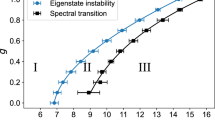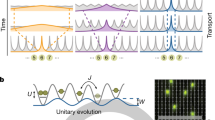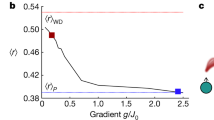Abstract
Strongly correlated systems can exhibit unexpected phenomena when brought in a state far from equilibrium. An example is many-body localization, which prevents generic interacting systems from reaching thermal equilibrium even at long times1,2. The stability of the many-body localized phase has been predicted to be hindered by the presence of small thermal inclusions that act as a bath, leading to the delocalization of the entire system through an avalanche propagation mechanism3,4,5,6,7,8. Here we study the dynamics of a thermal inclusion of variable size when it is coupled to a many-body localized system. We find evidence for accelerated transport of thermal inclusion into the localized region. We monitor how the avalanche spreads through the localized system and thermalizes it site by site by measuring the site-resolved entropy over time. Furthermore, we isolate the strongly correlated bath-induced dynamics with multipoint correlations between the bath and the system. Our results have implications on the robustness of many-body localized systems and their critical behaviour.
This is a preview of subscription content, access via your institution
Access options
Access Nature and 54 other Nature Portfolio journals
Get Nature+, our best-value online-access subscription
$29.99 / 30 days
cancel any time
Subscribe to this journal
Receive 12 print issues and online access
$209.00 per year
only $17.42 per issue
Buy this article
- Purchase on Springer Link
- Instant access to full article PDF
Prices may be subject to local taxes which are calculated during checkout




Similar content being viewed by others
References
Alet, F. & Laflorencie, N. Many-body localization: an introduction and selected topics. C. R. Phys. 19, 498–525 (2018).
Abanin, D. A., Altman, E., Bloch, I. & Serbyn, M. Colloquium: many-body localization, thermalization, and entanglement. Rev. Mod. Phys. 91, 021001 (2019).
Nandkishore, R. & Gopalakrishnan, S. Many body localized systems weakly coupled to baths. Ann. Phys. 529, 1600181 (2017).
De Roeck, W. & Huveneers, F. Stability and instability towards delocalization in many-body localization systems. Phys. Rev. B 95, 155129 (2017).
Luitz, D. J., Huveneers, F. & De Roeck, W. How a small quantum bath can thermalize long localized chains. Phys. Rev. Lett. 119, 150602 (2017).
Thiery, T., Huveneers, F., Müller, M. & De Roeck, W. Many-body delocalization as a quantum avalanche. Phys. Rev. Lett. 121, 140601 (2018).
Crowley, P. J. D. & Chandran, A. Avalanche induced coexisting localized and thermal regions in disordered chains. Phys. Rev. Research 2, 033262 (2020).
Morningstar, A., Colmenarez, L., Khemani, V., Luitz, D. J. & Huse, D. A. Avalanches and many-body resonances in many-body localized systems. Phys. Rev. B 105, 174205 (2022).
Schreiber, M. et al. Observation of many-body localization of interacting fermions in a quasirandom optical lattice. Science 349, 842–845 (2015).
Smith, J. et al. Many-body localization in a quantum simulator with programmable random disorder. Nat. Phys. 12, 907–911 (2016).
Choi, J.-Y. et al. Exploring the many-body localization transition in two dimensions. Science 352, 1547–1552 (2016).
Rubio-Abadal, A. et al. Many-body delocalization in the presence of a quantum bath. Phys. Rev. X 9, 041014 (2019).
Lukin, A. et al. Probing entanglement in a many-body–localized system. Science 364, 256–260 (2019).
Lüschen, H. P. et al. Observation of slow dynamics near the many-body localization transition in one-dimensional quasiperiodic systems. Phys. Rev. Lett. 119, 260401 (2017).
Rispoli, M. et al. Quantum critical behaviour at the many-body localization transition. Nature 573, 385–389 (2019).
Abanin, D. A. et al. Distinguishing localization from chaos: challenges in finite-size systems. Ann. Phys. 427, 168415 (2021).
Panda, R. K., Scardicchio, A., Schulz, M., Taylor, S. R. & Žnidarič, M. Can we study the many-body localisation transition? Europhys. Lett. 128, 67003 (2019).
Sierant, P., Delande, D. & Zakrzewski, J. Thouless time analysis of Anderson and many-body localization transitions. Phys. Rev. Lett. 124, 186601 (2020).
Šuntajs, J., Bonča, J., Prosen, T. & Vidmar, L. Quantum chaos challenges many-body localization. Phys. Rev. E 102, 062144 (2020).
Šuntajs, J., Bonča, J., Prosen, T. & Vidmar, L. Ergodicity breaking transition in finite disordered spin chains. Phys. Rev. B 102, 064207 (2020).
Luitz, D. J. & Lev, Y. B. Absence of slow particle transport in the many-body localized phase. Phys. Rev. B 102, 100202 (2020).
Kiefer-Emmanouilidis, M., Unanyan, R., Fleischhauer, M. & Sirker, J. Evidence for unbounded growth of the number entropy in many-body localized phases. Phys. Rev. Lett. 124, 243601 (2020).
Kiefer-Emmanouilidis, M., Unanyan, R., Fleischhauer, M. & Sirker, J. Absence of true localization in many-body localized phases. Phys. Rev. B 103, 024203 (2021).
Sels, D. Bath-induced delocalization in interacting disordered spin chains. Phys. Rev. B 106, L020202 (2022).
Agarwal, K., Gopalakrishnan, S., Knap, M., Müller, M. & Demler, E. Anomalous diffusion and Griffiths effects near the many-body localization transition. Phys. Rev. Lett. 114, 160401 (2015).
Bar Lev, Y., Cohen, G. & Reichman, D. R. Absence of diffusion in an interacting system of spinless fermions on a one-dimensional disordered lattice. Phys. Rev. Lett. 114, 100601 (2015).
Žnidarič, M., Scardicchio, A. & Varma, V. K. Diffusive and subdiffusive spin transport in the ergodic phase of a many-body localizable system. Phys. Rev. Lett. 117, 040601 (2016).
Gopalakrishnan, S., Agarwal, K., Demler, E. A., Huse, D. A. & Knap, M. Griffiths effects and slow dynamics in nearly many-body localized systems. Phys. Rev. B 93, 134206 (2016).
Agarwal, K. et al. Rare-region effects and dynamics near the many-body localization transition. Ann. Phys. 529, 1600326 (2017).
Potter, A. C., Vasseur, R. & Parameswaran, S. A. Universal properties of many-body delocalization transitions. Phys. Rev. X 5, 031033 (2015).
Vosk, R., Huse, D. A. & Altman, E. Theory of the many-body localization transition in one-dimensional systems. Phys. Rev. X 5, 031032 (2015).
Gopalakrishnan, S. et al. Low-frequency conductivity in many-body localized systems. Phys. Rev. B 92, 104202 (2015).
Weiner, F., Evers, F. & Bera, S. Slow dynamics and strong finite-size effects in many-body localization with random and quasiperiodic potentials. Phys. Rev. B 100, 104204 (2019).
Khemani, V., Lim, S. P., Sheng, D. N. & Huse, D. A. Critical properties of the many-body localization transition. Phys. Rev. X 7, 021013 (2017).
Khemani, V., Sheng, D. N. & Huse, D. A. Two universality classes for the many-body localization transition. Phys. Rev. Lett. 119, 075702 (2017).
Kelly, S. P., Nandkishore, R. & Marino, J. Exploring many-body localization in quantum systems coupled to an environment via Wegner-Wilson flows. Nucl. Phys. B 951, 114886 (2020).
Griffiths, R. B. Nonanalytic behavior above the critical point in a random Ising ferromagnet. Phys. Rev. Lett. 23, 17–19 (1969).
McCoy, B. M. Incompleteness of the critical exponent description for ferromagnetic systems containing random impurities. Phys. Rev. Lett. 23, 383–386 (1969).
Setiawan, F., Deng, D.-L. & Pixley, J. H. Transport properties across the many-body localization transition in quasiperiodic and random systems. Phys. Rev. B 96, 104205 (2017).
Kaufman, A. M. et al. Quantum thermalization through entanglement in an isolated many-body system. Science 353, 794–800 (2016).
Kubo, R. Generalized cumulant expansion method. J. Phys. Soc. Jpn 17, 1100–1120 (1962).
Acknowledgements
We acknowledge fruitful discussions with K. Agarwal, V. Khemani, M. Knap, M. Lebrat and J. Marino. We are supported by grants from the National Science Foundation, the Gordon and Betty Moore Foundations EPiQS Initiative, an Air Force Office of Scientific Research MURI program, an Army Research Office MURI program, the Swiss National Science Foundation (J.L.) and the NSF Graduate Research Fellowship Program (S.K.). The Flatiron Institute is a division of the Simons Foundation. D.S. is supported by the AFOSR grant FA9550-21-1-0236 and NSF grant OAC-2118310.
Author information
Authors and Affiliations
Contributions
J.L., S.K., M.R., A.L., R.S. and J.K. contributed to conducting the experiment, and collecting and analysing the data. S.K. performed the numerical simulations. The theoretical concepts were developed together with D.S. and E.D. M.G. supervised the work. All the authors contributed to writing the manuscript and discussions.
Corresponding author
Ethics declarations
Competing interests
M.G. is co-founder and shareholder of QuEra Computing. All other authors declare no competing interests.
Peer review
Peer review information
Nature Physics thanks Giovanni Modugno and the other, anonymous, reviewers for their contribution to the peer review of this work.
Additional information
Publisher’s note Springer Nature remains neutral with regard to jurisdictional claims in published maps and institutional affiliations.
Supplementary information
Supplementary Information
Supplementary Figs. 1–5, Table 1 and discussion.
Rights and permissions
Springer Nature or its licensor (e.g. a society or other partner) holds exclusive rights to this article under a publishing agreement with the author(s) or other rightsholder(s); author self-archiving of the accepted manuscript version of this article is solely governed by the terms of such publishing agreement and applicable law.
About this article
Cite this article
Léonard, J., Kim, S., Rispoli, M. et al. Probing the onset of quantum avalanches in a many-body localized system. Nat. Phys. 19, 481–485 (2023). https://doi.org/10.1038/s41567-022-01887-3
Received:
Accepted:
Published:
Issue Date:
DOI: https://doi.org/10.1038/s41567-022-01887-3
This article is cited by
-
Emergence of highly coherent two-level systems in a noisy and dense quantum network
Nature Physics (2024)
-
Eigenstate properties of the disordered Bose–Hubbard chain
Frontiers of Physics (2024)
-
Quantum avalanches wipe out the effects of disorder in interacting systems
Nature (2023)
-
Reviving product states in the disordered Heisenberg chain
Nature Communications (2023)



